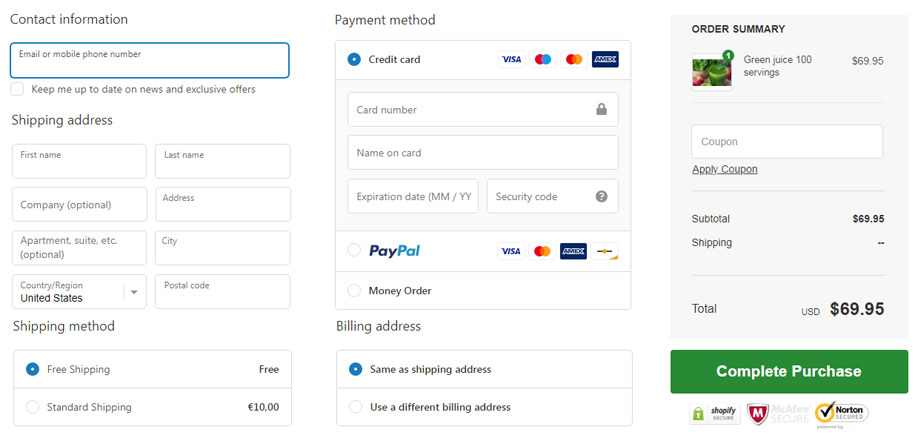
User experience(UX) has become a cornerstone of success in the eCommerceindustry. With online retail sales projected to reach a staggering $6.5 trillion by 2023, businesses must prioritize creating an engaging and intuitive shopping environment to attract and retain customers.
A seamless user experience not only boosts conversion rates but also fosters customer loyalty, transforming casual browsers into repeat buyers. For instance, 88% of online customersare likely to leave a website after a poor experience, underscoring the need for a focus on UX.
This article delves into the essential components of eCommerce user experience, offering actionable insights and best practices to enhance the shopping journey for customers.
Understanding User Experience In ECommerce
eCommerce user experience encompasses every interaction a customer has with an online store, from the moment they land on the homepage to the completion of their purchase and beyond.
A well-designed user experience facilitates intuitive navigation, clear product discovery, and a smooth checkout process, all of which contribute to customer satisfaction.
For example, if a customer struggles to find what they’re looking for, they may leave your site for a competitor's. Highlighting the contrast between effective and poor UX helps make this concept tangible.
The Importance Of ECommerce UX
Statistics On UX
Research reveals that 88% of online customersare likely to leave a website after a poor experience. This statistic underscores the significant impact of user experience on customer retention and sales.
Furthermore, 40% of online shoppersabandon a website due to unattractive design or confusing navigation, demonstrating the direct correlation between UX and conversion rates. A positive user experience can lead to increased customer satisfaction, which in turn enhances brand loyalty.
Connection To Revenue
A well-optimized user experience translates directly to revenue. Happy customers are more likely to return, resulting in a higher lifetime value for businesses.
By investing in user experience, eCommerce stores can achieve a substantial return on investment through improved conversion rates and customer retention.
Key Components Of User Experience
1. Website Design
Aesthetics play a crucial role in user experience. An appealing website should reflect the brand's identity while ensuring a cohesive and professional look.
Utilizing a stable color scheme, high-quality images, and a clean layout can create an inviting atmosphere that encourages visitors to explore.
For example, brands like Appleand Nikeare known for their visually stunning, user-friendly designs that enhance the shopping experience.
2. Navigation
Intuitive navigationis vital for guiding users through the shopping experience. A well-organized menu, clear categories, and a functional search bar enable customers to quickly find what they are looking for.
Effective filtering options also help users narrow down their choices based on specific criteria, enhancing product discoverability. The Wayfairsite, for instance, uses clear categories and a robust search function to help customers easily locate products.
3. Loading Speed
Website speed is a critical factor in user retention. Studies show that 53% of visitorswill abandon a webpage if it takes longer than three seconds to load.
Optimizing images, minimizing code, and utilizing content delivery networks (CDNs) are essential strategies for ensuring fast loading times.
Implementing these practices can significantly reduce bounce rates and keep users engaged.
4. Mobile Optimization
With over 70% of eCommerce salesoccurring on mobile devices, ensuring a mobile-responsive design is non-negotiable. A seamless mobile experience involves using sticky navigation, click-to-call buttons, and features like pinch-to-zoom for product images.
For example, Amazonhas successfully optimized its mobile site to facilitate easy browsing and purchasing.
Related: Top Amazon SEO Tips Every Seller Should Know - Cracking The Code
5. Call-to-Action (CTA) Buttons
CTAsare crucial for guiding users through their shopping journey. Effective CTA buttons should stand out visually and use actionable text that encourages users to take the next step, whether that's adding a product to their cart or completing their purchase.
For example, using phrases like “Buy Now” or “Shop the Sale” can create a sense of urgency and prompt action.
6. Sales Funnels
Building sales funnelsrather than just static web pages can help guide users toward conversion. Each stage of the funnel should be designed to minimize friction, providing users with the information they need to make informed purchasing decisions.
By strategically placing CTAs and optimizing landing pages, eCommerce sites can enhancethe overall shopping experience.
7. Multiple Payment Options
Offering a variety of payment methods caters to diverse customer preferences and increases the likelihood of completing a sale.
Popular options include credit/debit cards, digital wallets, and services like PayPal, ensuring a secure and convenient checkout experience. The more payment options you provide, the more likely you are to accommodate your customers' needs.
Read Also: Debit Card, Cash, Forex - Understanding The Differences
8. Custom 404 Page
A custom 404 pageis an often-overlooked element that can significantly impact user experience. When a user encounters a broken link or an unavailable page, a well-designed 404 page can provide helpful navigation options, directing them back to relevant content instead of leaving them frustrated. This not only minimizes bounce rates but also reflects a commitment to user satisfaction.
Enhancing User Interaction
9. User-Friendly Checkout Process
A complicated checkout process is one of the leading causes of cart abandonment. Streamlining the process involves reducing the number of required fields, offering guest checkout options, and providing clear shipping and payment information upfront.
For instance, Shopifyallows customers to complete purchases quickly and efficiently, which can significantly reduce cart abandonment rates.
10. Personalization
Leveraging data analytics to offer personalized product recommendations can significantly enhance user engagement.
By analyzing browsing history and preferences, eCommerce stores can tailor the shopping experience to meet individual customer needs. This customization not only improves the likelihood of conversion but also enhances customer satisfaction.
11. Customer Support Integration
Providing accessible customer support options, such as live chat and virtual assistance, can help address user concerns in real-time. This availability not only improves user experience but also builds trust with potential customers.
For example, Zapposis renowned for its excellent customer service, ensuring that shoppers feel valued and supported throughout their journey.
12. Customer Reviews And Testimonials
Incorporating customer reviews on product pages serves as social proof, helping to establish credibility. Studies show that nine out of ten consumersread reviews before making a purchase.
Positive feedback reassures potential buyers, while even negative reviews can enhance authenticity when handled properly.
13. Case Studies Or Examples
Highlighting successful eCommerce sites that have implemented effective UX strategies can inspire readers. For instance, the seamless navigation and robust review system of Amazonare prime examples of excellent user experience in action.
Implementing User Feedback
Actively seeking and capturing user feedback is essential for continuous improvement. Surveys, feedback forms, and customer reviews can provide valuable insights into areas that need enhancement.
Encouraging users to share their experiences fosters a culture of transparency and responsiveness.
Testing And Optimization
14. A/B Testing
A/B testing allows eCommerce stores to compare different versions of web pages to determine which performs better. Testing various elements, such as CTA buttons and layouts, can reveal insights that help optimize the user experience.
15. Analytics Tools
Utilizing analytics tools like Google Analyticscan provide valuable data on user behavior. Understanding how users interact with the site can help identify pain points and inform data-driven decisions for improvements.
16. Trends In ECommerce UX
Staying informed about emerging trends is crucial for maintaining a competitive edge. Current trends such as artificial intelligence (AI) for personalized shopping experiences, augmented reality (AR) for virtual try-ons, and voice search optimization are reshaping the eCommerce landscape. Adapting to these trends can provide businesses with a significant advantage.
17. Accessibility And Inclusivity
Ensuring that the website is accessible to users with disabilities is not only a legal requirement in many regions but also enhances the overall user experience. Following Web Content Accessibility Guidelines (WCAG) can help create an inclusive shopping environment that caters to all users.
FAQs About Improving ECommerce User Experience
What Is User Experience In ECommerce?
User experience in eCommerce refers to how users interact with an online store, including design, navigation, and the purchasing process. A positive UX enhances customer satisfaction and increases conversion rates.
Why Is Website Speed Important For UX?
Website speed is crucial because slow-loading pages can lead to higher bounce rates and abandoned carts. Faster websites improve user retention and overall satisfaction.
How Can Personalization Improve User Experience?
Personalization tailors the shopping experience to individual users by recommending products based on their browsing behavior and preferences, increasing engagement and conversion rates.
What Are Some Common UX Mistakes In ECommerce?
Common UX mistakes include complicated navigation, slow loading times, unclear product information, and a lengthy checkout process. Avoiding these pitfalls can significantly enhance user experience.
Conclusion
In summary, improving user experience in eCommerce is an ongoing process that involves understanding customer needs, implementing feedback, and adapting to new trends.
By focusing on key components such as website design, navigation, and personalized interactions, businesses can create a shopping experience that not only attracts customers but also fosters loyalty.
Embracing a user-first approach and continually optimizing based on analytics will help ensure that your eCommerce store thrives in a competitive landscape. Remember, a positive user experience leads to happier customers and increased sales.


